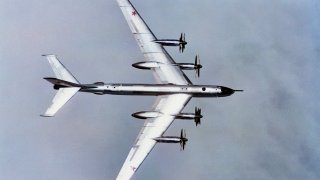Chinese and Russian Bombers Conducted Joint Air Patrol
The appearance to a Tu-95 in a Chinese and Russian joint strategic air patrol was a blast from the past, the propeller-powered bird looked out of place with the more modern PLAAF and Russian Air Force personnel in the skies.
For the ninth time since Beijing and Moscow established their cooperation agreement in 2019 and the eighth since December 2023, Chinese and Russian aircraft took part in a "joint strategic air patrol" last week. While past patrols were near the Alaska ADIZ (Air Defense Identification Zone), including a flight in July, the recent sortie was over the Sea of Japan, the East China Sea, and the western Pacific Ocean.
The aircraft included the Russian Aerospace Force's Tupolev Tu-95MS (NATO reporting Bear) and China's People's Liberation Army Air Force's (PLAAF's) Xi'an H-6K strategic bombers, the Russian Ministry of Defense had announced.
Chinese state media outlet The Global Times shared a video of the flight on X, the social media platform formerly known as Twitter. The video showed one Russian and two Chinese bombers being escorted by PLAAF J-16 fighters. It identified the Chinese warplanes as "H-6N bombers."
According to TheAviationist, the PLAAF bombers were the modernized variant and were "immediately recognizable in the video and photos due to the introduction of an air refueling probe and the bomb bay replaced by a semi-recessed with attachment points for air-launched ballistic missiles." If confirmed this would mark the first time the H-6N has taken part in a joint patrol mission with the Russian bombers.
The H-6N can carry the DF-21D, the air-launched variant of Beijing's infamous DF-21 "carrier killer" anti-ship missile.
Modernized Tu-95 Coming Soon?
Though it appears that the PLAAF has continued to upgrade its aging H-6 bombers, a license-built version of the Soviet Tupolev Tu-16 (NATO reporting name Badger), the Kremlin has also updated its Tu-95.
Rostec recently announced that the Tu-95MSM has incorporated "lessons learned from the ongoing special military operation," in Ukraine. According to Army Recognition, the Cold War-era bomber, which is among the oldest aircraft designs still flying anywhere in the world and is also the only propeller-powered bomber currently in operation, has been upgrading to fire ultra-long-range cruise missiles.
That includes the Kh-101 as well as the nuclear variant: the Kh-102.
"These missiles can strike targets up to 5,500 kilometers away, allowing the bomber to engage adversaries from deep within Russian airspace. This capability not only enhances its survivability by minimizing exposure to enemy air defenses but also makes it a tool for both conventional and nuclear deterrence. The ability to carry other advanced munitions broadens its operational scope, allowing it to undertake precision strikes against high-value targets," the Army Recognition report noted.
What haven't been upgraded are the engines, likely due to costs, and the fact that it would be hard to retrofit the aircraft for a modern powerplant. Seven decades ago, the choice of propeller-driven engines was made because jet engines burned through fuel far too quickly, and the Soviet Air Force could not refuel its bombers in flight.
Instead of being a speedy bomber, the Tu-95 was noted for being able to fly slowly and steadily to get the job done.
Moreover, it was among the only Soviet-era bombers that could fly a distance of 5,000 miles and strike targets within the United States from territory within its borders. The updated variants are reported to have a range that is greater than 9,300 miles (15,000 km).
Finally, though the name "Bear" was originally employed by NATO, it was adopted by the Kremlin as the aircraft's official nickname. The bomber was also a symbol of pride for the Soviet Union and often was demonstrated at European Air Shows.
Peter Suciu is a Michigan-based writer. He has contributed to more than four dozen magazines, newspapers, and websites with over 3,200 published pieces over a twenty-year career in journalism. He regularly writes about military hardware, firearms history, cybersecurity, politics, and international affairs. Peter is also a Contributing Writer for Forbes and Clearance Jobs. You can follow him on Twitter: @PeterSuciu. You can email the author: [email protected].
Image Credit: Creative Commons and/or Shutterstock.

